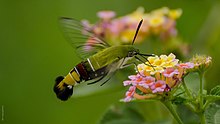en
names in breadcrumbs


Cephonodes hylas, the coffee bee hawkmoth, pellucid hawk moth or coffee clearwing, is a moth of the family Sphingidae. The species was first described by Carl Linnaeus in 1771. A widely distributed moth, it is found in the Near East, Middle East, Africa, India, Sri Lanka, Japan, Southeast Asia and Australia.[1][2]
It has transparent wings and a stout body like a bumble bee.[3] Its wingspan of 45–73 mm. Its marginal borders are very narrow and black. The abdomen varies in colour from yellow to green. Nominate subspecies has bright reddish 3rd and 4th abdominal segments. Larva has two colour forms, green and blackish. In greenish form, the body is greenish with a white-bordered blue dorsal line and a whitish sub-dorsal line ending in a yellow streak at the base of the horn. The head and spiracles are blue.[4] In the dark-coloured form, the head is brown or pale orange and the rest of the body is smoky black. Pupa dark brown.

Dorsal male
(from the collection of the MHNT)
Larvae are sluggish but eat very greedily and continuously. Its larvae feed on Burchellia, Gardenia, Kraussia, Pavetta and Vangueria species. Parasitoids such as Ooencyrtus papilionis and Blepharipa zebrine are found on larva.[5][6]
Cephonodes hylas larvae on Catunaregam spinosa in Hyderabad, India
Pellucid hawk moth in Bangalore, India
Cephonodes hylas, the coffee bee hawkmoth, pellucid hawk moth or coffee clearwing, is a moth of the family Sphingidae. The species was first described by Carl Linnaeus in 1771. A widely distributed moth, it is found in the Near East, Middle East, Africa, India, Sri Lanka, Japan, Southeast Asia and Australia.